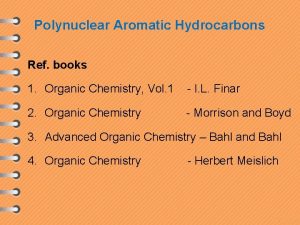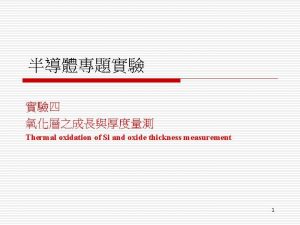Effect of Reaction Conditions on Oxidation of Anthracene

- Slides: 1

Effect of Reaction Conditions on Oxidation of Anthracene with a Vanadium Catalyst Cynthia R. Gerber, Ian J. Martin, Lea Nyiranshuti*, Luke Fulton*, Roy P. Planalp* cry 85@wildcats. unh. edu; ijx 4@wildcats. unh. edu; Parsons Hall, 23 Academic Way, Durham NH 03824 May 5 th, 2016 Introduction Catalyst Synthesis Anthracene Oxidation Catalysts are used to accelerate reactions by providing an alternate pathway and lowering the energy of activation (Figure 1). Vanadyl acetylacetonate has been chosen as a catalyst in the oxidation of anthracene to anthraquinone as it can be easily synthesized. The effects of the reaction conditions on the turnover number (TON) of the catalyst and percent yield of anthraquinone in the oxidation of anthracene were explored. This was done by performing the reaction several times under various conditions. The procedure for the synthesis of the vanadyl acetylacetonate catalyst was adapted from literature 1 and involved first dissolving vanadyl sulfate in water, followed by the addition 2, 4 -pentanedione and a solution of saturated sodium carbonate (Figure 2). The procedure for the oxidation of anthracene was adapted from literature 2, however the reaction time was decreased. Anthracene and the vanadium catalyst were dissolved in ethyl acetate followed by the addition of hydrogen peroxide (Figure 4). Figure 1. Schematic showing the effect of a catalyst on the energy of activation. Figure 2. Synthesis of vanadyl acetylacetonate. Figure 4. Synthesis of anthraquinone. Figure 5. 1 H NMR spectrum. Figure 3. IR (ATR) spectrum of the vanadyl catalyst. Figure 6. 13 C NMR spectrum. Future Work Results Acknowledgments Special thanks to Lea Nyiranshuti as well as Luke Fulton, Prof. Roy Planalp, and the Department of Chemistry at UNH for funding. References 1. Charleton, K. D. M. ; Prokopchuk, E. M. J. Chem. Educ. 2011, 88, 1155– 1157. 2. Men’shikov, S. Y. ; Vurasko, A. V. ; Petrov, L. A. ; Molochnikov, L. S. ; Novoseiova, A. A. ; Skryabina, Z. E. ; Saloutin, V. I. Russ. Chem. Bull. 1992, 41, 619– 622. number and Conditions TON Yield (%) Normal* 12 40 Half H 2 O 2** 8 26 Double catalyst 7 46 1 h** 2 6 1. 5 h 12 41 *Normal conditions are 500 mg anthracene, 25 mg catalyst, 20 m. L ethyl acetate, 15 m. L 30% of hydrogen peroxide solution at reflux for 2 h. **Performed by Martin. Table 1. Turnover oxidation conditions. of anthracene with varying reaction Conclusions The data agreed with what was described in the literature 1, except for the half H 2 O 2 reaction which showed a decrease in TON and percent yield compared to normal conditions where an increase was expected.

